Exploring Contemporary Pedagogical Debate in Creative Arts
VerifiedAdded on 2020/02/24
|7
|1633
|87
Essay
AI Summary
This essay delves into the contemporary pedagogical debates surrounding creative arts education, focusing on the evolution of teaching methods in the modern classroom. It examines various approaches, including critical learning pedagogy, which emphasizes critical thinking and social justice; creative pedagogy, which highlights the importance of fostering student creativity; and cultural diversity, which promotes inclusivity and the recognition of individual strengths. The essay also explores transformative pedagogies, personalized learning, and self-sustainability pedagogies, emphasizing the use of objects in learning, individualized instruction, and student self-evaluation. The author argues for a shift away from traditional standardized teaching methods, advocating for the adoption of modern approaches that empower students to solve problems creatively and apply their knowledge in real-world contexts. The conclusion emphasizes the need for a more flexible and student-centered curriculum in creative arts education.
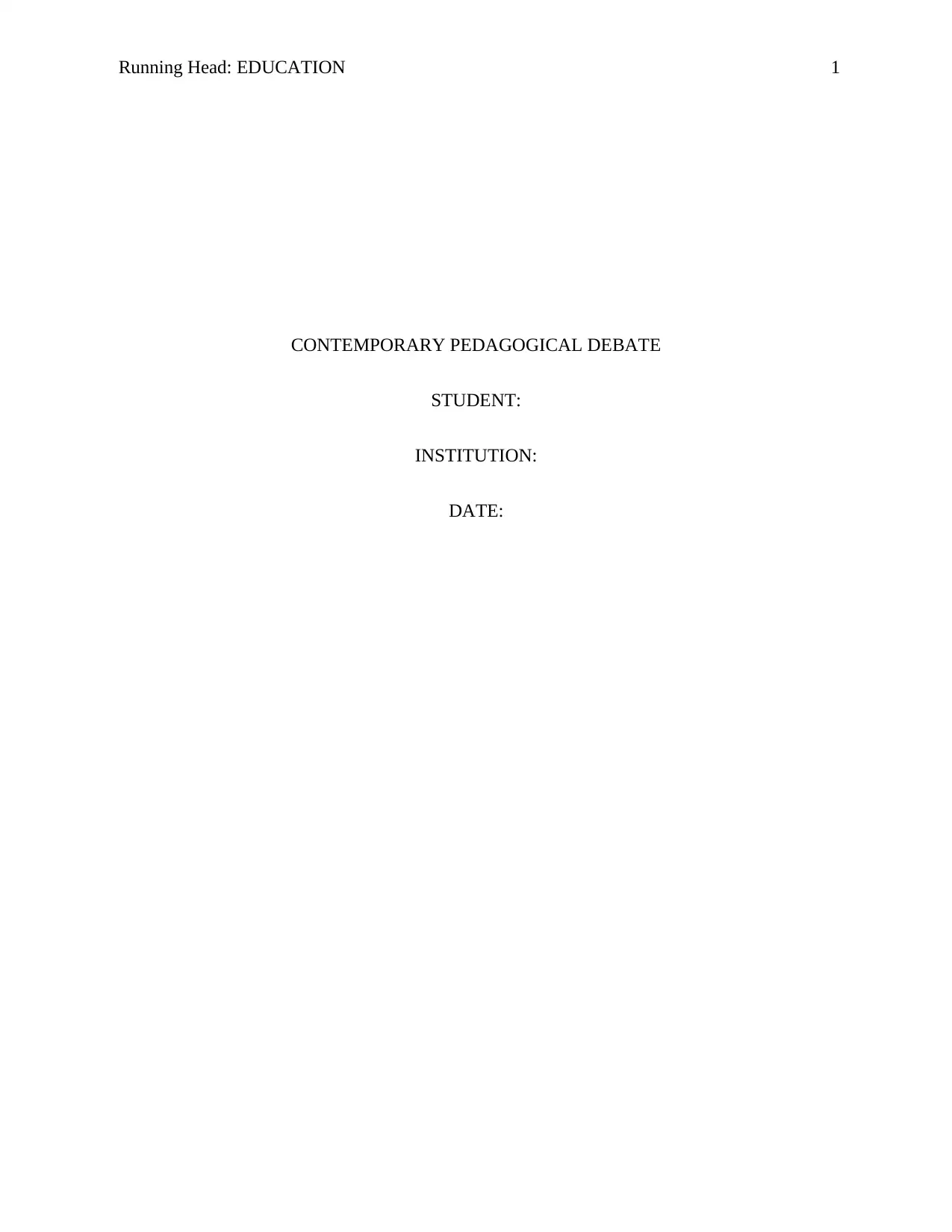
Running Head: EDUCATION 1
CONTEMPORARY PEDAGOGICAL DEBATE
STUDENT:
INSTITUTION:
DATE:
CONTEMPORARY PEDAGOGICAL DEBATE
STUDENT:
INSTITUTION:
DATE:
Paraphrase This Document
Need a fresh take? Get an instant paraphrase of this document with our AI Paraphraser

EDUCATION: 2
Contemporary pedagogical debate
Introduction
There have been a lot of debates in the recent past on the real meaning of pedagogy in the
modern society. Creative arts have no limitation in their place from which they should be taught.
Tutors have been arguing for the need to scrutinize technology will transform today's learning.
The modern pedagogies in creative arts include transformative pedagogies, discipline-based
critical design, cultural diversity, critical, self-sustainability, inquiry learning, reflection learning,
personalized learning and reflection learning. A primary importance of education is to make
students be able to think critically. It is an essential employment skill whether self-employment
or getting employed to work for other organizations (Robbinson, 2011). It is important for every
primary school to embrace the modern teaching methods and not just stick to the traditional
style. However, there are no quick solutions to change, and it needs time for every parent,
teacher, and pupil to understand before any implementation can begin individually. Learners in
the 21st Century must be furnished with the ability use the new pedagogies will create individuals
that are all-round for the betterment of the community.
Forms of creative arts pedagogy in the contemporary classroom
Critical learning pedagogy
The teaching of creative arts is inherent in creating solid knowledge stand similar to creating
social justice and democracy. When critical awareness is achieved, students will be able to think
critically. A connection is established between the student and the teaching process that will help
in establishing the individual's social context. Learning is articulated to all the activities in
reading, writing, speaking and thought (Wright, 2003). Mere knowledge only helps in finding a
Contemporary pedagogical debate
Introduction
There have been a lot of debates in the recent past on the real meaning of pedagogy in the
modern society. Creative arts have no limitation in their place from which they should be taught.
Tutors have been arguing for the need to scrutinize technology will transform today's learning.
The modern pedagogies in creative arts include transformative pedagogies, discipline-based
critical design, cultural diversity, critical, self-sustainability, inquiry learning, reflection learning,
personalized learning and reflection learning. A primary importance of education is to make
students be able to think critically. It is an essential employment skill whether self-employment
or getting employed to work for other organizations (Robbinson, 2011). It is important for every
primary school to embrace the modern teaching methods and not just stick to the traditional
style. However, there are no quick solutions to change, and it needs time for every parent,
teacher, and pupil to understand before any implementation can begin individually. Learners in
the 21st Century must be furnished with the ability use the new pedagogies will create individuals
that are all-round for the betterment of the community.
Forms of creative arts pedagogy in the contemporary classroom
Critical learning pedagogy
The teaching of creative arts is inherent in creating solid knowledge stand similar to creating
social justice and democracy. When critical awareness is achieved, students will be able to think
critically. A connection is established between the student and the teaching process that will help
in establishing the individual's social context. Learning is articulated to all the activities in
reading, writing, speaking and thought (Wright, 2003). Mere knowledge only helps in finding a
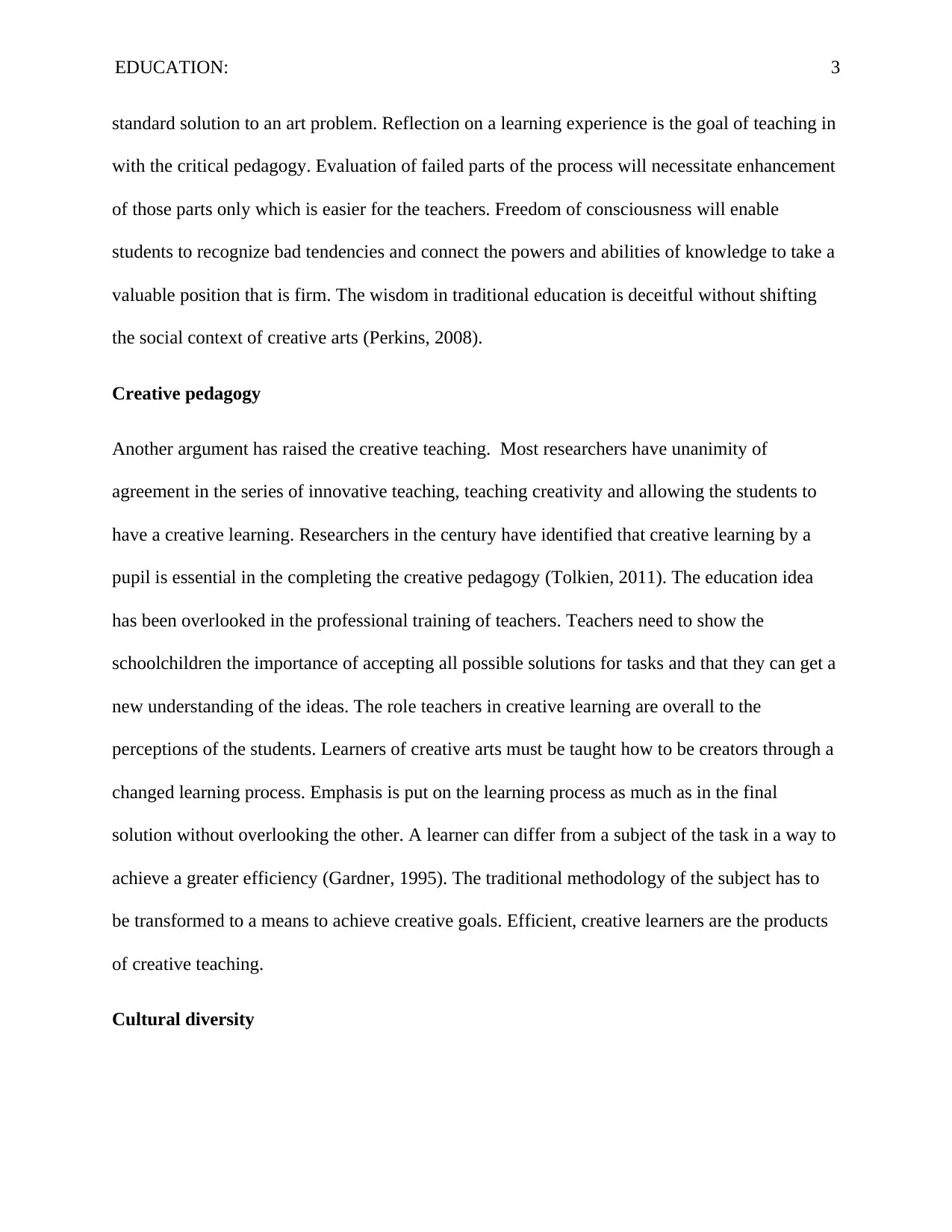
EDUCATION: 3
standard solution to an art problem. Reflection on a learning experience is the goal of teaching in
with the critical pedagogy. Evaluation of failed parts of the process will necessitate enhancement
of those parts only which is easier for the teachers. Freedom of consciousness will enable
students to recognize bad tendencies and connect the powers and abilities of knowledge to take a
valuable position that is firm. The wisdom in traditional education is deceitful without shifting
the social context of creative arts (Perkins, 2008).
Creative pedagogy
Another argument has raised the creative teaching. Most researchers have unanimity of
agreement in the series of innovative teaching, teaching creativity and allowing the students to
have a creative learning. Researchers in the century have identified that creative learning by a
pupil is essential in the completing the creative pedagogy (Tolkien, 2011). The education idea
has been overlooked in the professional training of teachers. Teachers need to show the
schoolchildren the importance of accepting all possible solutions for tasks and that they can get a
new understanding of the ideas. The role teachers in creative learning are overall to the
perceptions of the students. Learners of creative arts must be taught how to be creators through a
changed learning process. Emphasis is put on the learning process as much as in the final
solution without overlooking the other. A learner can differ from a subject of the task in a way to
achieve a greater efficiency (Gardner, 1995). The traditional methodology of the subject has to
be transformed to a means to achieve creative goals. Efficient, creative learners are the products
of creative teaching.
Cultural diversity
standard solution to an art problem. Reflection on a learning experience is the goal of teaching in
with the critical pedagogy. Evaluation of failed parts of the process will necessitate enhancement
of those parts only which is easier for the teachers. Freedom of consciousness will enable
students to recognize bad tendencies and connect the powers and abilities of knowledge to take a
valuable position that is firm. The wisdom in traditional education is deceitful without shifting
the social context of creative arts (Perkins, 2008).
Creative pedagogy
Another argument has raised the creative teaching. Most researchers have unanimity of
agreement in the series of innovative teaching, teaching creativity and allowing the students to
have a creative learning. Researchers in the century have identified that creative learning by a
pupil is essential in the completing the creative pedagogy (Tolkien, 2011). The education idea
has been overlooked in the professional training of teachers. Teachers need to show the
schoolchildren the importance of accepting all possible solutions for tasks and that they can get a
new understanding of the ideas. The role teachers in creative learning are overall to the
perceptions of the students. Learners of creative arts must be taught how to be creators through a
changed learning process. Emphasis is put on the learning process as much as in the final
solution without overlooking the other. A learner can differ from a subject of the task in a way to
achieve a greater efficiency (Gardner, 1995). The traditional methodology of the subject has to
be transformed to a means to achieve creative goals. Efficient, creative learners are the products
of creative teaching.
Cultural diversity
⊘ This is a preview!⊘
Do you want full access?
Subscribe today to unlock all pages.

Trusted by 1+ million students worldwide
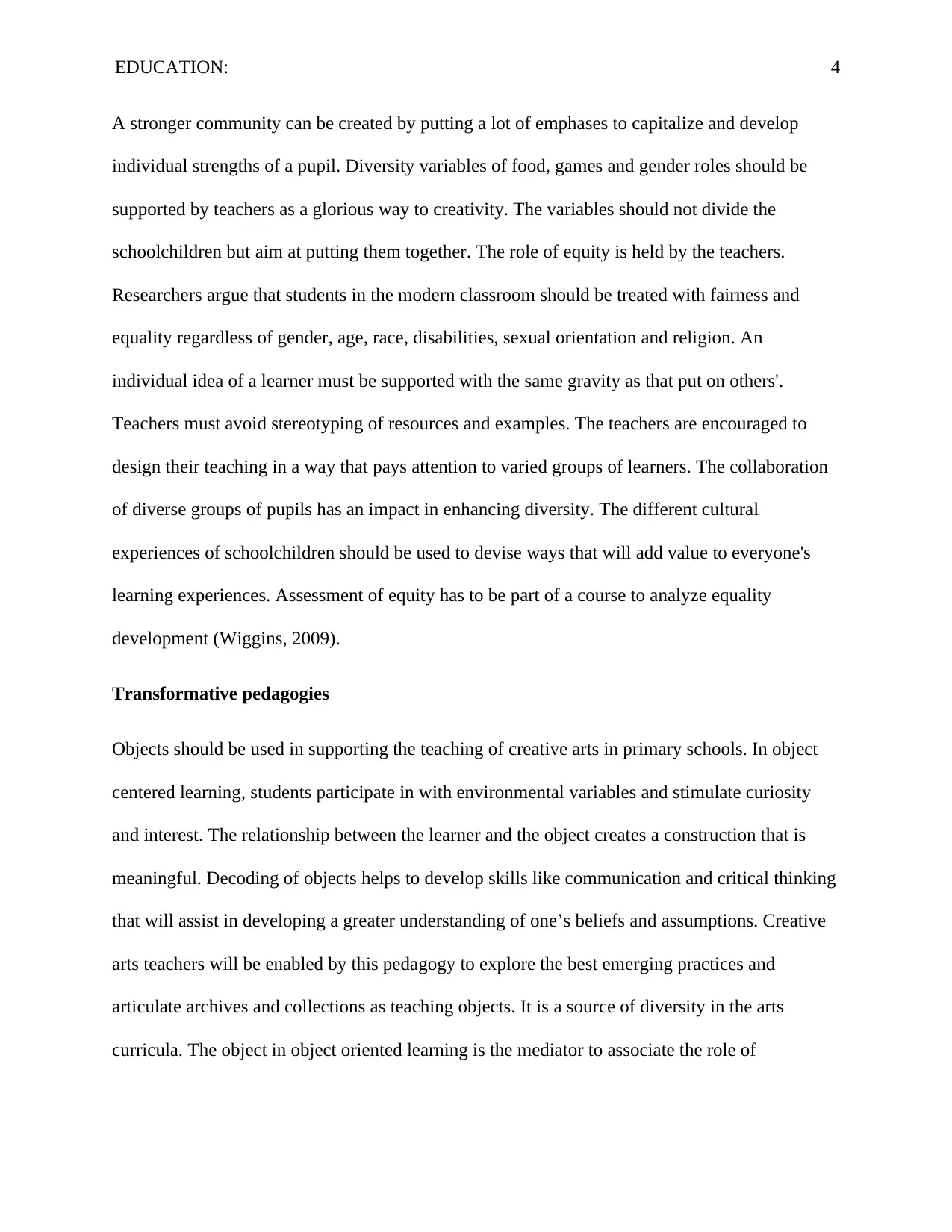
EDUCATION: 4
A stronger community can be created by putting a lot of emphases to capitalize and develop
individual strengths of a pupil. Diversity variables of food, games and gender roles should be
supported by teachers as a glorious way to creativity. The variables should not divide the
schoolchildren but aim at putting them together. The role of equity is held by the teachers.
Researchers argue that students in the modern classroom should be treated with fairness and
equality regardless of gender, age, race, disabilities, sexual orientation and religion. An
individual idea of a learner must be supported with the same gravity as that put on others'.
Teachers must avoid stereotyping of resources and examples. The teachers are encouraged to
design their teaching in a way that pays attention to varied groups of learners. The collaboration
of diverse groups of pupils has an impact in enhancing diversity. The different cultural
experiences of schoolchildren should be used to devise ways that will add value to everyone's
learning experiences. Assessment of equity has to be part of a course to analyze equality
development (Wiggins, 2009).
Transformative pedagogies
Objects should be used in supporting the teaching of creative arts in primary schools. In object
centered learning, students participate in with environmental variables and stimulate curiosity
and interest. The relationship between the learner and the object creates a construction that is
meaningful. Decoding of objects helps to develop skills like communication and critical thinking
that will assist in developing a greater understanding of one’s beliefs and assumptions. Creative
arts teachers will be enabled by this pedagogy to explore the best emerging practices and
articulate archives and collections as teaching objects. It is a source of diversity in the arts
curricula. The object in object oriented learning is the mediator to associate the role of
A stronger community can be created by putting a lot of emphases to capitalize and develop
individual strengths of a pupil. Diversity variables of food, games and gender roles should be
supported by teachers as a glorious way to creativity. The variables should not divide the
schoolchildren but aim at putting them together. The role of equity is held by the teachers.
Researchers argue that students in the modern classroom should be treated with fairness and
equality regardless of gender, age, race, disabilities, sexual orientation and religion. An
individual idea of a learner must be supported with the same gravity as that put on others'.
Teachers must avoid stereotyping of resources and examples. The teachers are encouraged to
design their teaching in a way that pays attention to varied groups of learners. The collaboration
of diverse groups of pupils has an impact in enhancing diversity. The different cultural
experiences of schoolchildren should be used to devise ways that will add value to everyone's
learning experiences. Assessment of equity has to be part of a course to analyze equality
development (Wiggins, 2009).
Transformative pedagogies
Objects should be used in supporting the teaching of creative arts in primary schools. In object
centered learning, students participate in with environmental variables and stimulate curiosity
and interest. The relationship between the learner and the object creates a construction that is
meaningful. Decoding of objects helps to develop skills like communication and critical thinking
that will assist in developing a greater understanding of one’s beliefs and assumptions. Creative
arts teachers will be enabled by this pedagogy to explore the best emerging practices and
articulate archives and collections as teaching objects. It is a source of diversity in the arts
curricula. The object in object oriented learning is the mediator to associate the role of
Paraphrase This Document
Need a fresh take? Get an instant paraphrase of this document with our AI Paraphraser
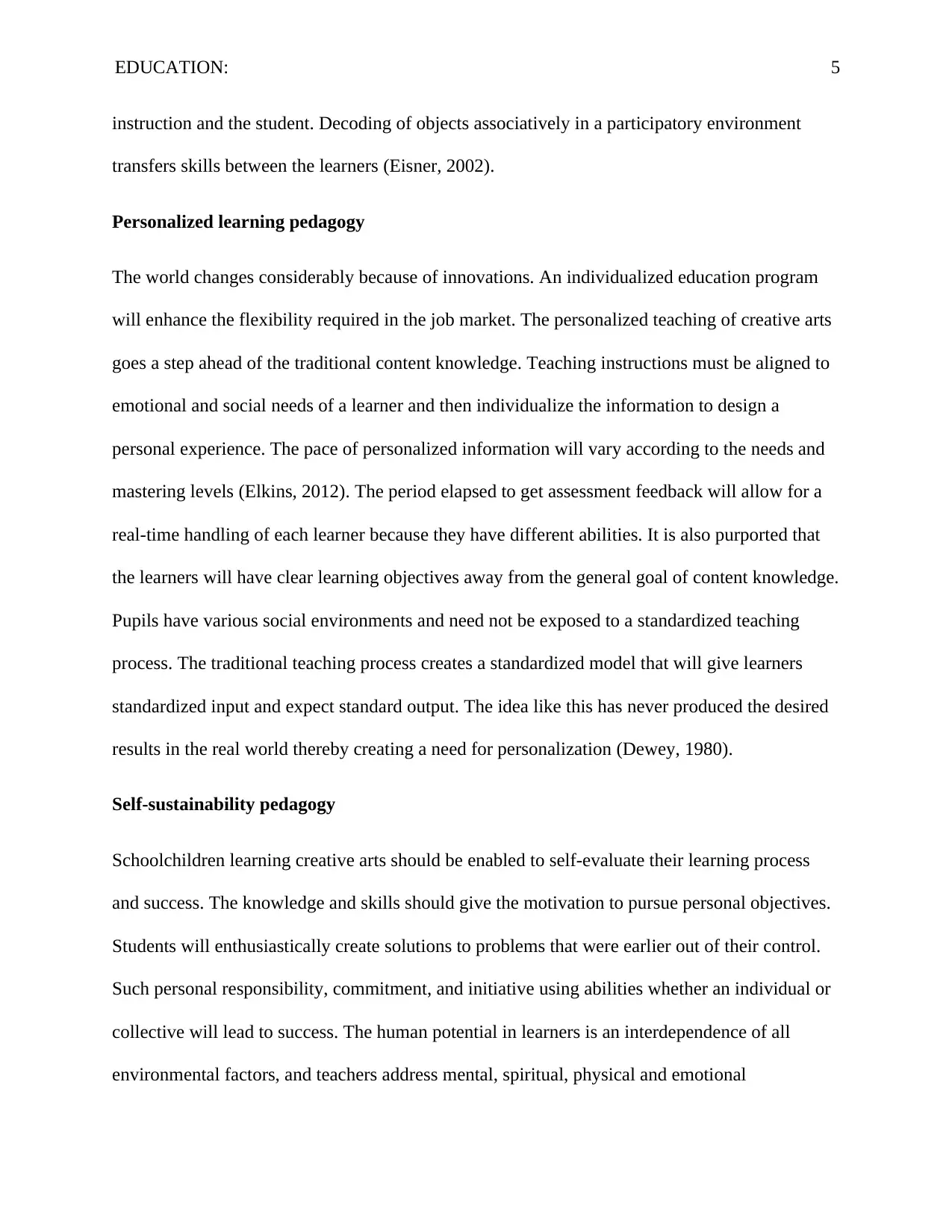
EDUCATION: 5
instruction and the student. Decoding of objects associatively in a participatory environment
transfers skills between the learners (Eisner, 2002).
Personalized learning pedagogy
The world changes considerably because of innovations. An individualized education program
will enhance the flexibility required in the job market. The personalized teaching of creative arts
goes a step ahead of the traditional content knowledge. Teaching instructions must be aligned to
emotional and social needs of a learner and then individualize the information to design a
personal experience. The pace of personalized information will vary according to the needs and
mastering levels (Elkins, 2012). The period elapsed to get assessment feedback will allow for a
real-time handling of each learner because they have different abilities. It is also purported that
the learners will have clear learning objectives away from the general goal of content knowledge.
Pupils have various social environments and need not be exposed to a standardized teaching
process. The traditional teaching process creates a standardized model that will give learners
standardized input and expect standard output. The idea like this has never produced the desired
results in the real world thereby creating a need for personalization (Dewey, 1980).
Self-sustainability pedagogy
Schoolchildren learning creative arts should be enabled to self-evaluate their learning process
and success. The knowledge and skills should give the motivation to pursue personal objectives.
Students will enthusiastically create solutions to problems that were earlier out of their control.
Such personal responsibility, commitment, and initiative using abilities whether an individual or
collective will lead to success. The human potential in learners is an interdependence of all
environmental factors, and teachers address mental, spiritual, physical and emotional
instruction and the student. Decoding of objects associatively in a participatory environment
transfers skills between the learners (Eisner, 2002).
Personalized learning pedagogy
The world changes considerably because of innovations. An individualized education program
will enhance the flexibility required in the job market. The personalized teaching of creative arts
goes a step ahead of the traditional content knowledge. Teaching instructions must be aligned to
emotional and social needs of a learner and then individualize the information to design a
personal experience. The pace of personalized information will vary according to the needs and
mastering levels (Elkins, 2012). The period elapsed to get assessment feedback will allow for a
real-time handling of each learner because they have different abilities. It is also purported that
the learners will have clear learning objectives away from the general goal of content knowledge.
Pupils have various social environments and need not be exposed to a standardized teaching
process. The traditional teaching process creates a standardized model that will give learners
standardized input and expect standard output. The idea like this has never produced the desired
results in the real world thereby creating a need for personalization (Dewey, 1980).
Self-sustainability pedagogy
Schoolchildren learning creative arts should be enabled to self-evaluate their learning process
and success. The knowledge and skills should give the motivation to pursue personal objectives.
Students will enthusiastically create solutions to problems that were earlier out of their control.
Such personal responsibility, commitment, and initiative using abilities whether an individual or
collective will lead to success. The human potential in learners is an interdependence of all
environmental factors, and teachers address mental, spiritual, physical and emotional

EDUCATION: 6
components of the schoolchildren. The students will be enlightened on societal interactions in
social lives and governance (Rose, et al. 1998). Design of learning models should value
multidisciplinary recognition, objectives and determination of methods, negotiation abilities and
flexibility.
Conclusion
My view is that the modern classroom pedagogy of creative arts in primary schools is that
creativity has to be enhanced to give pupils flexibility in solving emerging problems. The
application of personal learning and transformative processes has to be applied in education
curriculum for creative arts disciplines. The traditional standardized teaching curricula should be
altered to accommodate the needs of the modern classroom and to create proactive students and
individuals. Finally, the government through the ministry of education should discourage the
traditional methodology of teaching as it creates learners who over-adapt to survive in a problem
instead of solving the problem. Pupils must be empowered to apply their knowledge and skills in
the external environment to enhance enthusiasm and a self-reliance effort to solving tasks.
components of the schoolchildren. The students will be enlightened on societal interactions in
social lives and governance (Rose, et al. 1998). Design of learning models should value
multidisciplinary recognition, objectives and determination of methods, negotiation abilities and
flexibility.
Conclusion
My view is that the modern classroom pedagogy of creative arts in primary schools is that
creativity has to be enhanced to give pupils flexibility in solving emerging problems. The
application of personal learning and transformative processes has to be applied in education
curriculum for creative arts disciplines. The traditional standardized teaching curricula should be
altered to accommodate the needs of the modern classroom and to create proactive students and
individuals. Finally, the government through the ministry of education should discourage the
traditional methodology of teaching as it creates learners who over-adapt to survive in a problem
instead of solving the problem. Pupils must be empowered to apply their knowledge and skills in
the external environment to enhance enthusiasm and a self-reliance effort to solving tasks.
⊘ This is a preview!⊘
Do you want full access?
Subscribe today to unlock all pages.

Trusted by 1+ million students worldwide
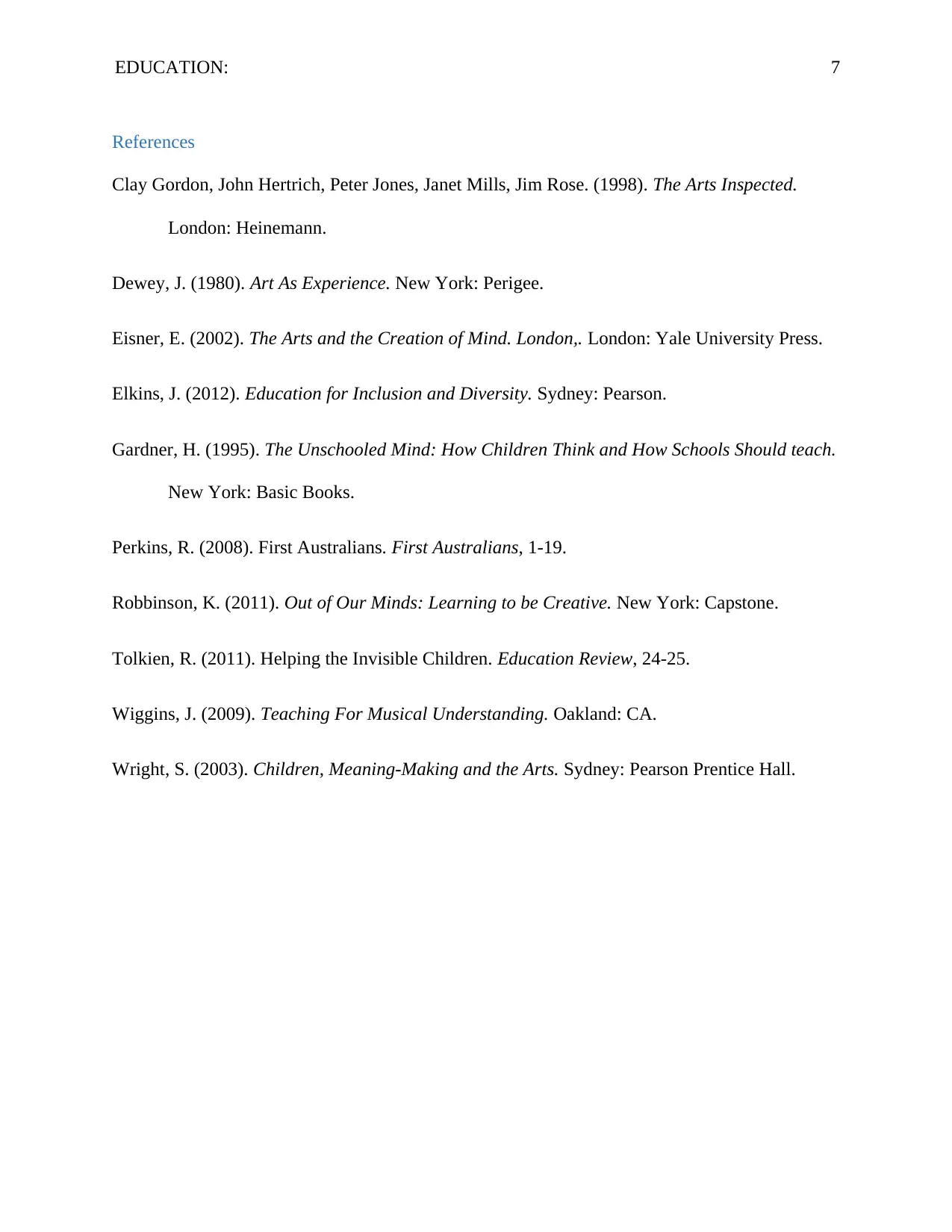
EDUCATION: 7
References
Clay Gordon, John Hertrich, Peter Jones, Janet Mills, Jim Rose. (1998). The Arts Inspected.
London: Heinemann.
Dewey, J. (1980). Art As Experience. New York: Perigee.
Eisner, E. (2002). The Arts and the Creation of Mind. London,. London: Yale University Press.
Elkins, J. (2012). Education for Inclusion and Diversity. Sydney: Pearson.
Gardner, H. (1995). The Unschooled Mind: How Children Think and How Schools Should teach.
New York: Basic Books.
Perkins, R. (2008). First Australians. First Australians, 1-19.
Robbinson, K. (2011). Out of Our Minds: Learning to be Creative. New York: Capstone.
Tolkien, R. (2011). Helping the Invisible Children. Education Review, 24-25.
Wiggins, J. (2009). Teaching For Musical Understanding. Oakland: CA.
Wright, S. (2003). Children, Meaning-Making and the Arts. Sydney: Pearson Prentice Hall.
References
Clay Gordon, John Hertrich, Peter Jones, Janet Mills, Jim Rose. (1998). The Arts Inspected.
London: Heinemann.
Dewey, J. (1980). Art As Experience. New York: Perigee.
Eisner, E. (2002). The Arts and the Creation of Mind. London,. London: Yale University Press.
Elkins, J. (2012). Education for Inclusion and Diversity. Sydney: Pearson.
Gardner, H. (1995). The Unschooled Mind: How Children Think and How Schools Should teach.
New York: Basic Books.
Perkins, R. (2008). First Australians. First Australians, 1-19.
Robbinson, K. (2011). Out of Our Minds: Learning to be Creative. New York: Capstone.
Tolkien, R. (2011). Helping the Invisible Children. Education Review, 24-25.
Wiggins, J. (2009). Teaching For Musical Understanding. Oakland: CA.
Wright, S. (2003). Children, Meaning-Making and the Arts. Sydney: Pearson Prentice Hall.
1 out of 7
Related Documents
Your All-in-One AI-Powered Toolkit for Academic Success.
+13062052269
info@desklib.com
Available 24*7 on WhatsApp / Email
![[object Object]](/_next/static/media/star-bottom.7253800d.svg)
Unlock your academic potential
Copyright © 2020–2025 A2Z Services. All Rights Reserved. Developed and managed by ZUCOL.




